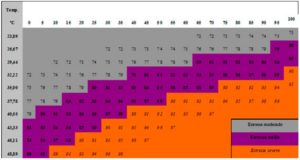Thermal Comfort Zone
In late spring and early summer dairy cows literally feel the effect of high temperatures and relative humidity on the skin. In this section we have already presented several articles bringing techniques to ameliorate thermal stress in dairy animals with management tips, facilities and nutrition. In this article we will discuss two subjects related to thermal stress: the comfort zone or the thermoneutral zone and the THI – temperature and humidity index. These items, although not direct techniques to attenuate the thermal stress of the animals, can be great tools for technicians and producers to monitor the thermal conditions in order to avoid stressful environments to the animals.
Thermal comfort zone or thermoneutrality
The homeothermic animals, according to the species, breed, production level, physiological stage and nutritional plane, present an ambient temperature range in which they are in thermal comfort, called thermoneutrality zone (figure 1) . In the thermoneutral zone, the thermoregulator system is not activated, either to capture or dissipate heat. Thus, energy expenditure for maintenance is minimal, resulting in maximum productive efficiency. The limits of the thermoneutral zone are: the lower critical temperature (TCI) and the upper critical temperature (TCS). Below the TCI, the cow under stress from the cold, and above the TCS, under heat stress (BACCARI JUNIOR, 1998).
To know an animal is or not in its zone of comfort it is fundamental to establish the lower and upper TCs. However, there is still some divergence among the authors about what would be the highest critical temperature for lactating cows, since the so-called specialized breeds of milk had their origins in temperate regions. According to Berman (1985) the upper CT scan would be between 25 to 26ºC for lactating cows, regardless of whether they had undergone previous acclimatization or level of production. This generalized specificity of higher critical temperature contradicts the considerations of Yousef and Johnson (1985) according to which the zone of thermoneutrality varies with the physiological state and the environmental conditions.
Another author, Fuquay (1997) considered for European cattle, the value of higher critical temperature is between 25 to 27ºC. According to Nääs (1989), as a function of relative air humidity and local solar radiation, the thermoneutral band could be restricted between 7 and 21ºC. Huber (1990) considered as suitable for the thermal comfort of lactating cows air temperatures between 4 and 26ºC. It is noticed that despite the variation between the authors all the superior CTs remained within the range of 21 to 27 ºC.
Thermal stress may be due to temperatures below the TCI or above the TCS. Brazil, because it is located geographically, for the most part, between the equator and the tropic presents problems with the stress caused by heat, that is, above the TCS.
THI – temperature and humidity index
One of the great problems of considering only the zone of thermoneutrality to know if an animal is or not in a stressful environment is the fact that this index does not consider other stressful environmental factors such as the relative humidity of the environment, Wind speed and solar radiation. In an attempt to use all these factors, researchers attempted to create indices, among them the temperature and humidity index (THI) developed by Thom (1959) as a comfort index for humans. Johnson et al. (1962) and their coworkers observed significant decreases in dairy cow production, associated with the increase in THI, which has since been used to describe the thermal comfort of these animals. This index can be calculated from the dry bulb temperature and the relative humidity of the air, as described by Johnson (1980). Thus:
THI = Ts + 0.36 Tpo + 41.2 where:
Ts = dry bulb thermometer temperature, ° C; Tpo = temperature of the dew point, ° C.
When the THI result is greater than 72, the animal can be said to be in a stressful environment. Not all producers are able to measure THI on their properties, either for lack of knowledge, equipment or even time. So, to facilitate there are tables on the market (some veterinary drug companies and even on the internet provide free of charge) tables, as below, featuring THI stressors for lactating cows. To use the table, it is enough for the producer to know the average temperature and relative humidity of his region.
Table 1. Temperature and humidity index (Adapted from Johnson et al., 1962)
It is worth noting that, although it is widely used, THI, according to some authors, is already an outdated tool because it does not consider the heat produced by the animal itself.
Once the concepts of Comfort Zone and THI are understood, technicians and producers can easily monitor the environment in which animals remain in order to identify risk situations related to thermal stress as soon as possible and thus to seek measures (physical, nutritional or Management) to alleviate this problem that is part of a large part of the tropical herds.

